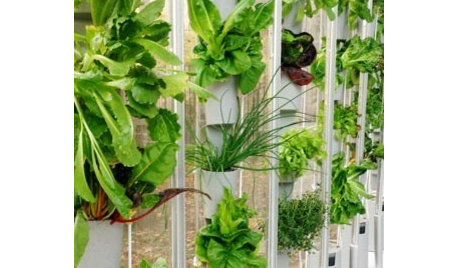The uselessness of high P fertilizers
Some of you may recall that I have long maintained that high phosphorus(P) fertilizers are pointless.
I also am a fan of Dyna-Gro fertilizers for container usage.
I was asked recently 'If high P fertilizers are so useless then why does Dyna-Gro make and market them?'
My answer was simply to have a product that people wanted, but that was just my opinion. I decided to ask the company (Dyna-Gro) about this. At first I got a very brief response from a representative that wasn't at all satisfying so I asked that rep to forward my question to someone responsible for deciding what their formulations would be. I ended up getting a response from the CEO. Here it is, I think you will find it interesting.
*******************
You are correct. We market a high P (Liquid Bloom) "believe" they need this. As you have noted, our Foliage-Pro does a great job start to finish. However, it is simpler to give the market what they think they need than to try to reeducate it. There is some evidence to believe that low N helps to convince a plant to stop its vegetative growth and move into its reproductive phase (flowering), but environmental factors are probably more important. P is typically 5th or 6th in order of importance of the six macronutrients. There is little scientific justification for higher P formulas, but marketing does come into play for the vast majority of users who lack any real understanding of plant nutritional requirements. Therefore, the market is flooded with a plethora of snake oil products that provide little benefit and can actually do harm. For example, one exhibitor at a hydroponic trade show had a calcium supplement with 2% calcium derived from calcium chloride. Can you guess what continued application of 2% chloride would do to plants?'\
I hope this answers your question and am sorry for Zina's inaccurate response.
Cordially,
Dave Neal, CEO
Dyna-Gro Nutrition Solutions
2775 Giant Rd.
Richmond, CA 94806
800-Dyna-Gro, Fax: 510-233-0198
grodave@aol.com
www.dyna-gro.com
Comments (35)
gringojay
14 years agoModern balanced diet for one person annually uses agriculturally +/- 22.5 kg of mined phosphorus ( person's ingestion of all sources of nutritional phosphorus = +/- 1/2 kg per year).
Phosphorus production from economic exploitable sources is estimated to peak around the year 2035 & then mining will be drawing down on those reserves (ie: tipping point of available & digging into remaining 1/2).
Morocco, with P most reserves, will possibly be the only place to farm in 100 years if the whole world gets on the "Bloom" band wagon.tapla (mid-Michigan, USDA z5b-6a)
14 years agoI was going to post the whole original text I posted last year on the same subject, but I'll just link to it in case there is interest. As JaG said, there really is NEVER a need for a fertilizer with the middle number higher than either of the other 2 numbers for use in container culture.
Al
Here is a link that might be useful: More on high-P fertilizers
Related Professionals
Edmond Landscape Architects & Landscape Designers · Citrus Heights Landscape Architects & Landscape Designers · 70037 Landscape Architects & Landscape Designers · Fort Myers Landscape Contractors · Lake Zurich Landscape Contractors · Post Falls Landscape Contractors · Irvington Landscape Contractors · Arlington Window Contractors · Morton Grove Window Contractors · Vero Beach Window Contractors · Brooklyn Park Fence Contractors · Madison Fence Contractors · Markham Fence Contractors · Mill Valley Fence Contractors · Severna Park Fence Contractorsgeorgeiii
14 years agoOk let's have another opion. What makes you think either of them know what their talking about. I say this is what makes organic verus inorganic. The real point people really don't talk about if you only see it in the industrial light. That's the problem. See industy is about force feeding verus aborbing. With industry force feeding a plant can make it cough, throw up, then stop feeding altogether. Or think of it another way. Why does urine work as well as store bought fertilizer. Because you are part of this time. You and the plants that surrond you are of the same time peroid. Oil based fertilizers are millions of years out of our time biology. See went a plant gets natural fertilizer it absorbs it into every strucure and cell space it can. Just gathering waiting for the moment the N levels drop. Understand too that the plant is greening up, lots of leaves and branching. Change to just plain water and boom. Or to put it another way. Using a liter of fluid you piss out everyday added to 5 gallons of water verus charts, meters, measures and no one really caring on a frightful scale that's pollutining the whole planet. Now don't get wrong, I'm a polluter too. (small one) (HA) Sorry I sometimes amuse myself when I write things down. Here's something else too. This is America. We not only have a choice of stores to go to. We have shelves of choices to choose from. I mean damn...it's packaged, cubed and ready to roll. If there's even a tear in a bag they'll sell it to you at half price. And what do we do with it. We put it in other packages and throw it away. During holidays you can't go a block with out seeing plants along with their medium being thrown away. This stuff is being ripped fom the earth, mixed, processed and stuffed into plastic baggies so you can just throw it away. Part of that carbon foot print thing. Anyone can point a finger at me and say "you too". That's true. Now I'm sorry if I ramble I'd like to think I'm talking to some one not just typing words across a screen. So that's my thoughts on the P(ee) question
veracan
14 years agoI totally agree. We are an N-P-K driven society. For most that is all that matters and the higher the number the better. What a shame. This is true not only for plants and flowers, but turf as well. That is one of the many reasons I garden organic, and change the type of organic supplements I use from time to time.
Here is a link that might be useful: green nation gardens
tapla (mid-Michigan, USDA z5b-6a)
14 years agoOh brother! ;o) Industrial light? Force feeding? Cough/throw-up? ...... much more. Urine way over your head, Mr. George. Lol
It's nice that you guys take SUCH a firm stand - and with such strong opinions. You should be able to explain it all thoroughly so even us dummies can understand ..... Well?
Al
justaguy2
Original Author14 years agoActually the point of the post was to show that even the CEO of a plant nutrition company agrees high P fertilizers are useless.
Doesn't really have anything to do with force feeding or organic rants. There is a time and place for everything, but I would kindly request that this thread not be the place.
marshallpoint
14 years agoThanks JaG. I appreciated your post and the honesty of the CEO. You offer important info regarding both gardening and consumer issues. I also found the response both inappropriate and bizarre. I've learned to look for posts by both you and Al and have come to rely on them for all the info and guidance you have to share. Keep up the good work.
deep_roots
14 years agoWhile I agree on high P fertilizer being not needed. I think some of the misguided actions are based on trying to throttle back the application of N to diminish lots of vegetative growth at the expense of fruit production. Perhaps what the market needs is an appropriate understanding of how and when to switch a plant from vegetative growth to blooming and fruiting. Unfortunately, tricking a plant into blooming earlier can backfire in an uncontrolled environment and the plant may revert to vegetative growth.
georgeiii
14 years agoHey guys don't worry, I don't feel offended. I send pictures right here to prove my way of thought. And really truth be told where else should I post it because container gardening is about to take off. Where else should I rant about wasting a gallon and a half of water to flush maybe 4 to 8 ounces of piss down a drain. Where else should I rant about tearing out whole sections of nature to throw it away some where else. Am I getting a glimmer of "open mind" yet. You laugh about a plant coughing, a plant throwing up? Why do you think some plants attract insects and others right next to them don't. Because just like flies their attracted to sh$t. If you feel the need to defend something please be my guest. But what is it that your defending? A CEO's right to sell you something you don't need at a high price because you don't know any better. People come here to learn. American are facing hard times that haven't even started yet and everyone see it happening. Containers are going to be the only way we can match our vegetable needs. RANT!! You haven't begun to hear me RANT. Now (with a little tie strighting motion) we get back to the P questin. We got a good example in another post about Onions. Onions are a good example of high P needs. And by the way I'm not organic minded. I just like growing plants. Some one mention about growing leaves in 7 weeks that are 17" tall. Well mine are 19" tall in 4 weeks. As soon as I find my tape measure I'll send pictures. Well enough of this cyber chit chat things to do.
justaguy2
Original Author14 years agoWhere else should I rant about wasting a gallon and a half of water to flush maybe 4 to 8 ounces of piss down a drain.
In your own thread or a thread someone else starts that is about wasting water rather than about the futility of high P fertilizers? But what is it that your defending?
Nothing. I am not sure if you correctly understood the OP. Your 'rants' are simply not on topic and I am asking you to discontinue them in this thread. Feel free to start your own.
meyermike_1micha
14 years agoI really appreciate what you shared justaguy2!!
Thanks for making us understand things that REALLY do matter, and that some of us would of never known...
Thanks man!
Mike:-)
gringojay
14 years agoSeems while I was out in the bush the Phosphorus for "bloom" trend really took hold.
It's allure might have crossed over into edible crops from orchid culture when indoor cannabis growing became popularized .
Commercialization of the cannabis plant puts a premium on the flower buds' resinous content & is not orientated to mature seed fruition.
Hydroponic fertilization of cannabis plants made it practical to force an aberration from the plants natural developmental cycle.
Translated into food production, where a distinct end product is desired, the manipulation of Phosphorus makes less sense.
It would be interesting to see the statistical data totals on marketable edible produce yielded from plants given high P, with their theoretically abundant flowering, & comparison weight totals from standard P fertilized edible plants.tapla (mid-Michigan, USDA z5b-6a)
14 years agoHigh-P fertilizers are pretty much a throw-back to when bedding plants were started outdoors in cold frames and cold soils made P uptake difficult. The theory was that increasing the P levels would at least make SOME P available.
Al
deep_roots
14 years agoIncreasing P in outdoor use was introduced for more reasons than cool soil. Soil condition, pH, and excess or out-of-balance amounts of other nutrients could make the P unavailable. In my outdoor garden, my soil test indicated far more P was present than what I ever needed. My plants indicated a lack, which turned out to be self-inflicted from earlier days when pH, alkalinity, iron levels, and compost choices affecting P availability where not checked. I was able to increase P availability to my plants without adding additional P.
Even balanced Foliar Pro will not be available in balanced proportions when other factors remain unchecked. However to blindly throw high levels of P at the problem is a mistake considering P limitations arise from multiple sources.
lesmatzek209
14 years agohi justaguy, you said that you use dyna gro foliage pro in
your s.w.c. have you used it in raised beds with pottiing
soil ?. have you ever used G.H. flora nova ? if yes how do
you compare them to each other ?
thanks les matzekronalawn82
14 years agojustaguy2, I can agree with your stand against high phosphorus fertilizer applications; indeed I can agree with anyone's stand against all indiscriminate high-content fertilizer applications. But how high is high? My experience tells me that it must be in relation to the crop and specifically in relation to what part of the crop is the end product. My experience is with sugar cane, a grass, but the end product is the sucrose content of the stalk. It is mind boggling to contemplate the thought,the time and the labor that went into a simple statement like:
"For the PLANT crop highest yields (tons sugar per acre) are associated with a PHOSPHORUS content of 0.200% DRY MATTER in the TVD (top visible dewlap)leaf at AGE 24 WEEKS." Capitals denote the variables.
In the RATOON crops (harvests until next replanting)the PHOSPHORUS content was 0.180%DM at 12 WEEKS.
I have many reasons to believe that testing and field experimentation is not done as extensively or intensively in horticulture as it is in commercial agriculture. The result has been that ideas have been marketed to whet the appetite of the consumer and products have been sold to satisfy that appetite. The CEO's admission you quoted is a lamentable confirmation of this vicious cycle.
We must all share the responsibility for this undesirable state of affairs and it is heartening to see the awareness generated by people, topics and forums like these. But if we allow our passion for our point of view to override clear thought, then we are headed in the same old direction on a parallel path.
Maybe I should have slept on this before posting it.gringojay
14 years agoPhosphorus is not extremely mobile in the soil.
In circumstances where it is applied as a fertilizer it can accumulate (readers can readily find studies of this on the internet, my linking skill is nil).
Some forum posters have reported their soil analysis showing high phosphorus content, although apparently think it is naturally occurring.
In containers the implication is to monitor your phosphorus ratio & flush the growing medium if you become concerned that your total dissolved fertilizer solids applied used excessive phosphorus ( read Tapla's fertilizer post about total dissolved solids relevance for orientation) .justaguy2
Original Author14 years agolesmatzek209,
I haven't tried GH Flora Nova. In terms of a comparison it would be enough to look at the ingredients list to compare.
I also don't use Foliage Pro in my raised beds. My raised beds have a lot of compost and organic matter in them and the native soil underneath them is very high in P and adequate in K so all I add there is a source of N.
Ronalawn82,
The total amount of nutrients or specific nutrients a plant requires can vary from plant to plant and growth stage within the same plant. However the ratio of nutrients changes little.
In other words one plant may require more P than another plant, but I have yet to find *any* plant that uses more P than it does N or K and often plants use more Ca than P as well.
When I say high P fertilizers are useless in containers this says nothing about the *total* amount of P the plant will require, rather it says there is no plant that uses P at the same rate as it uses N and K therefore a fertilizer that contains more P than N or K is useless and wasteful. The high P ratio isn't providing the plant what it needs efficiently.
As an example, let's say that over the course if it's life a plant will need 100 units of N, 20 units of P and 80 units of K. If the fertilizer we choose is 10-50-10 then by the time we have provided the plant with it's 100 units of N we have also applied 500 units of P and 100 units of K. 480 units of P were not needed by the plant and 20 units of K were not needed. Those 480 units of extra P increase salt concentrations (potentially reducing the plant's ability to take up water and nutrients) and end up in water bodies unless they encounter something (a low P soil perhaps) that 'traps' them.
greengrass12
14 years agogeorgii, the pictures of your plants are magnificant. I would not have believed that plants could grow that well in such limited and unique spaces if I had not seen your pictures from time to time. Your results tell me that you are doing something right.
I use a little bat guano to boost the flowering stage of my tom and pepper plants. I got a 100 or so orange habs from one plant in a 11 inch container. Love that bat guano 1-11-0.
salpal
14 years agoI think what is most distressing is that the CEO admits it's more simple to give "the market" what they want rather than "re-educate it". It's not that I expect the CEO to "re-educate the market", but a legitimate question is- WHO "educated" the market incorrectly in the first place? I find it interesting the amount of products we have and think we need which are actually unnecessary. Suddenly those selling the products feel that our demand requires that they sell them to us, yet we may question whether they didn't market the products to begin with.
lesmatzek209
14 years agohi justaguy,
would orchid bark mix be o.k. ? for your 5-1-1 mix ? thanks les matzek.justaguy2
Original Author14 years agoHi Les,
The 5-1-1 mix is Tapla's, not mine. It's a mix many have used since he does such a good job of explaining why it's a better mix than most.
From what I have read in the past I would say orchid bark is probably fine, but I really can't say for certain. If it is pine or fir bark, no sapwood and is the right size then it will be fine.
__________________Salpal,
I agree with your sentiments. I understand that the fertilizer companies have to make money and if the market demands something they either sell it or lose business. At the same time these companies do more than simply have a product offering, they push it with pretty aggressive marketing that perpetuates the myth.
rob_thompson
14 years agoI use High Phosphorus fertilizer (Bone-meal) for Tomatoes, but more for the Calcium than for the Phosphorus (to prevent blossum-end rot). If you look at commercial hydroponic mixes (the book by Howard Resh is an excellent detailed reference and survey of the industry), you will not find a single mix that has higher Phosphorus than Nitrogen.
catlover_gardener
14 years agoYou know try as I might I just cannot understand georgii's comments. We all know America is facing tough times and we waste a lot, but what has that got to do with high P in ferts?
Spend more time reading and listening and learning than emailing useless verbage!! We all have rights, but this is somewhat annoying....
ronalawn82
14 years agojustaguy2, I sense that we are in agreement. I was trying to point that levels of the elements vary for crop, age, stage and even for different tissue in the same plant. You reiterated the same ideas. The example I used is perhaps unfortunate but it was a crop where everything was measured. Elements were applied in large quantities, from different sources, were sometimes fixed in the soils and, most surprising of all, were far less than what was measured at harvest. Where did the extra come from? Maybe I should bear in mind that the forum is "Container plants" and not "Agronomy" but in mitigation, I wish to plead that the basics do not change very much. I was mildly disappointed, however, to read that
"........unfortunately even university extension publications are often so hopelessly out of date that they continue to propagate the myth of high P ferts." Unless or until other sources can match the Universities' strict standards of investigation, we should acknowledge that they provide us the best scientific results. How we choose to interpret and apply these results is personal and subjective.justaguy2
Original Author14 years agoI too find it unfortunate that universities continue to propagate myths, but they do. It's actually quite odd because at a single university I will read some outstanding research on a subject and then go to the 'lighter reading' stuff the extension service offers for home growers and find their basic info contradicts their research.
In no way does this mean I don't respect university research, it's generally the best out there. It would just be nice if one department talked to the other and got things updated ;)
ronalawn82
14 years agojustaguy2, one of the basic lessons in "Extension Methods" is "Pitching to the right level". Additionally, the public audience can be stratified into a sort of hierarchial structure; at the top there is that small group (and getting larger, hopefully) of "Innovators" while at the bottom are the equally small group (and getting smaller, hopefully) of "Non Adopters". This might explain why the different presentations to separate targetted audiences. The CES have held sessions for the 'education' of the "Commercial Sector" and then held "Train the Trainers" sessions for the same group to put forward presentation methods for their "Homeowner" audience. The objective always is the most effective path from the researcher to the end user.
I just thought that I would share my own appreciation for a "Service" (in the truest sense of the word) by adding my perspective which is shaped by a little knowledge and being the beneficiary of their findings.gringojay
14 years agoThe uptake of nutrients (& water) is not constantly going on throughout our 24 hour frame of reference.
Phosphorus (P) is particularly noteworthy in that throughout the plant cycle (for tomato, definitely) 35-40% of P uptake occurs during the dark.
When I drip fertilize garden plants , especially during flower blooming, I alter the ratio of total dissolved solids (TDS) to have a more substantial ppm of P after dark. (Many, & my tropical soil is low in P. Anywhere there is P does not mean it can be drawn very far through the soil by the roots to get at it.)
That said, the total P supplied to the plant in it's life is unchanged & what it gets at night is lower N ratio.
How much do the field plants get: " water weakly" is a good guideline.
In hydroponic/greenhouse ag development projects this is easiest due to the
controlled growing substrate you can measure ppm of fertilizer for.
Container gardening has been likened to hydroponics. Of course with top watering & bottom wicking the fertilization method differs.
Top waterers with free draining substrate who read this: 2-4 hours after sun set alter your fertigation to less N & steady as usual P; but do night water some times to give plant soluble P at the other time when it will take up P.
Wick waterers (SWC/BWB): hold P in adequate proportion & plant can get P in night feeding too; this timely availability of P is one of the yield factors seen with Raybo's 'Tainer yields (P translocates in the plant & things happen where they make noticeable difference - it has nothing to do with feeding excess P)boothbay
11 years agoJust wondering ...how are the orchids getting 'their' fertilizer out in the woods or wherever they grow naturally?
Nature seems to supply its own N-P-greentiger87
11 years agoThey get it from organic debris, bird droppings, etc that decompose and are washed over their roots and leaves by the frequent rain in their habitats. In addition, they form parasitic relationships with fungi that break down organic matter. Of course these plants have evolved to survive and reproduce, not to perform at the levels we expect - with aesthetics or flower productivity as the major concern. The NPK ratio they get in nature varies constantly depending on the conditions, time of year, etc. That doesn't mean you can't determine an ideal NPK ratio for maximum performance of a particular plant. That ideal ratio may not match what's naturally available at all.
calistoga_al ca 15 usda 9
11 years agoThe problem with publishing inaccurate material in university textbooks, it lasts forever and lacks the power to correct itself. Subsequent publications on the same subject by a different author will contain the same inaccuracy without attribution to the original text. Is it a wonder the average "Joe Gardener" has a problem sorting it all out? Al
















justaguy2Original Author